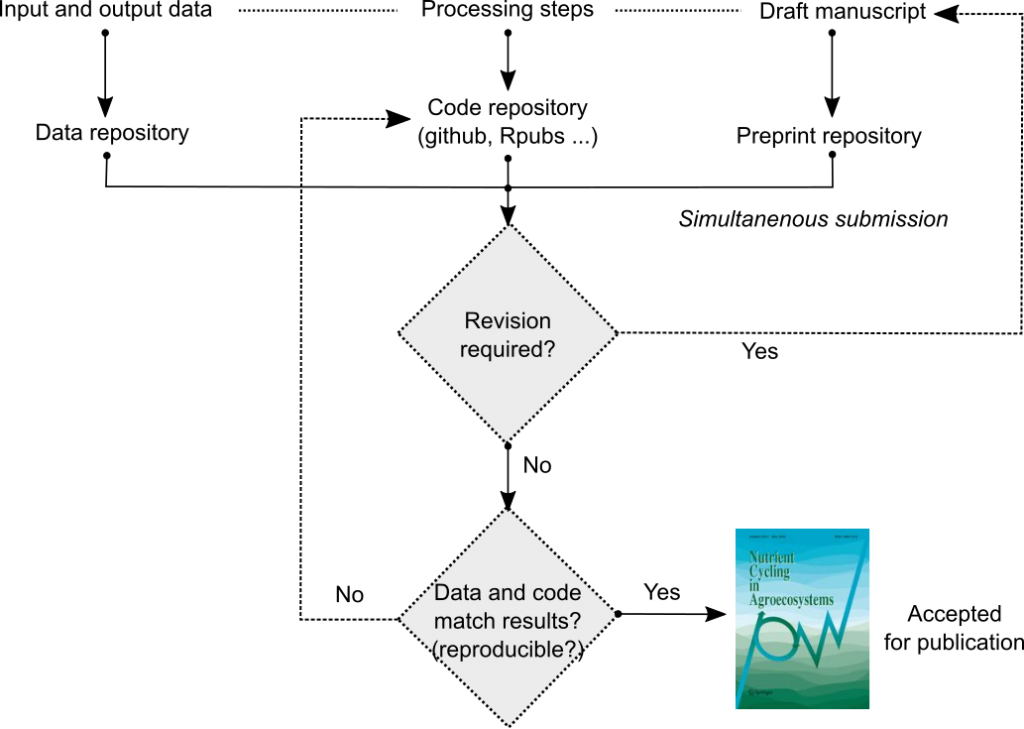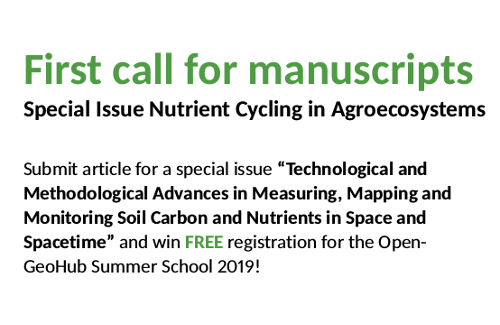Call for manuscripts
Technological and Methodological Advances in Measuring, Mapping and Monitoring Soil Carbon and Nutrients in Space and Spacetime
Special issue Nutrient Cycling in Agroecosystems Journal (SI:NutrientMapping)
Special issue editors: T. (Tom) Hengl, M. (Madlene) Nussbaum and P. (Pierre) Roudier
Editor-in-Chief: J. (Johannes) Lehmann
Submissions are now closed. Due to a low number of submissions this special issue has been cancelled.
Context
Soil is the largest terrestrial sink of carbon, and therefore a major opportunity for the mitigation greenhouse gases emissions. While removing carbon from the atmosphere, sequestering more carbon in soil can lead to a range of benefits, such as improved fertility. This places agricultural soils, in particular, at the nexus of two major global challenges: food security and climate change. Consequently, there has been an increasing interest in novel technologies for measuring, mapping and monitoring of soil carbon and soil nutrients. But, how to organize sampling and monitoring of soil carbon and nutrients to achieve objective answers to key soil carbon management questions? What is happening with nutrients over large areas and over longer time scales? Which nutrients are in deficit and which might lead to supply risks? How significant is soil pollution and soil degradation and how is it related to soil fertility? Can machine learning frameworks (e.g. Tensor-Flow, H2O), data mining, High Performance Computing, and proximal and remote soil sensing technologies be combined to boost accuracy of carbon and nutrient maps without significant additional costs? What are the optimal statistical frameworks and best practices for producing reliable soil carbon and nutrient maps? How does the use of spatial soil information helps improve the value of soil resources, and support its communication to policy makers? How will such technologies impact food production and land management in 20 to 30 years? In which directions will technology and applications develop in the next 10 years?
This special issue invites researchers in the field of soil science, agronomy, ecology, data science and pedometrics to submit original research work connected with development and application of novel technologies and methods that can help answer some of the questions above. Our special interest is in using novel technologies such as soil sensing and image recognition, automated sensor networks, unmanned aerial vehicles (UAVs) and publicly available remote sensing products (such as NASA’s Landsat 7 & 8 and ASTER missions, ESA’s Sentinel 2 and other Copernicus land products, JAXA’s Advanced Land Observing Satellite ALOS, LiDAR, TanDEMx and similar missions), in combination with statistical learning, data mining and high performance computing.
Win Free registration!
First five (5) accepted papers for this special issue will be awarded a waived registration fees (names to be chosen by the contact author of the accepted paper) at the next OpenGeoHub Summer School 2019 (former GEOSTAT Summer School).
Scope
Specific topics include but are not limited to:
- Direct-to-digital soil mapping, from soil sensing to producing dynamic maps of soil carbon and nutrients,
- Integration of regional and global soil data, incorporation of scale into soil carbon and nutrient mapping,
- Ensemble methods / model averages for operational mapping,
- Estimation of uncertainty of spatial predictions in space and spacetime,
- Combination of expert-based soil evaluation and numeric approaches to soil mapping including soil sensing,
- Development of methods for predicting soil carbon and nutrients in space and spacetime (deriving soil carbon loss and gain),
- Development of sampling schemes for spatial monitoring of changes in soil carbon and nutrients possibly accounting for seasonal variation in the target soil property,
- Interdisciplinary developments spanning fields of pedometrics, econometrics and environmetrics,
Submission requirements
We require that all articles submitted for this issue come with documented computational steps (code) and/or data processing tutorials which are available publicly (github, Rpubs, Launchpad, Bitbucket or similar) and can be used to reproduce at least 2/3rd of key results (key tabular and graphical results). We also advise that the submitted works, as much as possible, involve using or distributing Open Data (meaning that the input and/or output data is registered under some of the Open Data licenses). Authors have full freedom to specify which of the key results are provided as reproducible research materials.
Submissions are now closed.
Reproducible research
Reproducibility check — conditions and workflows:
- At least 2/3rd of key results (listed in the cover letter by the authors) must pass the reproducibility test. Key results should comprise between 5–12 items. Reproducibility test will be organized by the special issue editors who will also comments on directly on the code submitted together with the article.
- Key results (including tables and graphs) that do not pass the reproducibility check will be returned to authors.
- For the final submission, all input data, processing steps (the code) and final manuscript must match exactly before the paper can be accepted for publication (see below). This corresponds to Level 2 or 3 standards of the RR as defined in Nosek et al. (2015).

Read more about reproducible research in:
- Nosek BA, et al. (2015) Promoting an open research culture. Science 348:1422–1425.
- Stodden, V., Seiler, J. and Ma, Z., (2018) An empirical analysis of journal policy effectiveness for computational reproducibility. Proceedings of the National Academy of Sciences, 115(11), pp.2584-2589.
- Somers, J. (2018) The Scientific Paper Is Obsolete, here’s what’s next. The Atlantic.
Submission guidelines
We highly recommend following these guidelines (in addition to the Journal submission guidelines) to speed up processing of the papers:
- Download the Springer template. For rmarkdown documents please use the Springer template.
- Once the paper is submission ready provide a list of key results in the cover letter. Then provide link to data and code for the at least 2/3rds of the key results.
- Initial submission will go through pre-screening and once all technical criteria have been met, it will be sent for peer-review.
- (Optional) after a submission has been accepted for publication, authors will be encouraged to place a copy of the whole project on http://osf.io including a preprint of the article (the Green Open Access publishing route). Contact authors which are employees of some of the government agencies or Universities that are under the Institutional Agreements can request Open Access without paying the processing chargers. Find out if your institution has an agreement with Springer. Read more in: The Springer Open Choice.
- Send an e-mail to editors with all links to data and code that can help in the review process. Your submission will then pass a technical check.
- If everything is OK you are ready to submit your manuscript via the Editorial system
Important dates:
The special issue is scheduled to be released in early 2019. Please note some important dates:
- First call: 2018, June 1st.
- Manuscript submission until 2018,
December 1st, December 15th. Manuscript evaluation until 2019, February 20th.Special issue publication in 2019, March.


